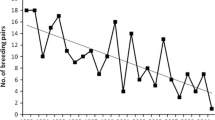Summary
Data from a standardized mist-netting programme (the so-called “MRI-Programm”) were used to assess the timing of breeding in Reed Warblers (Acrocephalus scirpaceus) at Lake Constance (South Germany). The number of Reed Warblers fledged early in the season increased significantly between 1976 and 1997 (rs=0.614; p<0.01). This is most probably due to a long-term increase in spring temperature as suggested by the high correlation between the number of early-fledged Reed Warblers and mean temperature in the first half of May (rs=0.416; p<0.01). While in the period from 1961 to 1980 the mean date of spring arrival was on the 26th of April, it shifted towards the 19th April from 1981 to 1997. However, the number of early-fledged Reed Warblers and the date of spring arrival are not significantly correlated. The lack of a significant correlation may be due to a number of reasons, for instance early arriving birds do not belong to the local population or there could be an observational bias among years. Yet, the most likely explanation is that the timing of breeding in Reed Warblers is triggered by vegetation growth and food supply rather than by the timing of spring arrival. There is growing body of evidence from this and other studies that the recent climate change is responsible for the shift in both the timing of migration and breeding in birds.
Zusammenfassung
In einem Untersuchungsgebiet am westlichen Bodensee (Halbinsel Mettnau) zeichnet sich zwischen 1976 und 1997 eine deutliche Zunahme früh ausgeflogener Teichrohrsänger ab, was auf ein früheres Brüten schließen läßt. Weiterhin hat sich die Erstankunft des Teichrohrsängers am Bodensee in den letzten 16 Jahren (1982–1997) im Vergleich zum Zeitraum 1961 bis 1980 um genau eine Woche verfrüht (im Mittel vom 26.4. auf den 19.4.). Während sich zwischen der jährlichen Erstankunft des Teichrohrsängers am Bodensee und der Zahl früh ausgeflogener Jungvögel kein statistisch gesicherter Zusammenhang finden läßt, ist die Temperatur in der ersten Maihälfte ein guter (statistisch signifikanter) Indikator für die Zahl früh ausgeflogener Teichrohrsänger.
Die vorliegende Untersuchung zeigt, daß sich offenbar auch Langstreckenzieher an die sich abzeichnende Klimaveränderung anzupassen beginnen.
Similar content being viewed by others
Literatur
Bairlein, F. (1981): Ökosystemanalyse der Rastplätze von Zugvögeln: Beschreibung und Deutung der Verteilungsmuster von ziehenden Kleinvögeln in verschiedenen Biotopen der Stationen des „Mettnau-Reit-Illmitz-Programmes“. Ökologie der Vögel 3: 7–137.
Bairlein, F. & Winkel, W. (1998): Vögel und Klimaveränderungen. In: Lozan, J.L., Grassl, H., Hupfer, P. & Sterr, H. (Hrsg.): Warnsignale aus der Klimaforschung: 281–285. Hamburg.
Beier, J. (1981): Untersuchungen an Drossel- und Teichrohrsänger (Acrocephalus arundinaceus, A. scirpaceus): Bestandsentwicklung, Brutbiologie, Ökologie. J. Ornithol. 122: 209–230.
Bergmann, F. (1998): Die Wegzugphänologie von Kleinvögeln in Mitteleuropa. Allensbach 1998.
Berthold, P. (1996): Control of Bird Migration. London.
Berthold, P. & Schlenker, R. (1975): Das „Mettnau-Reit-Illmitz-Programm“ — ein langfristiges Vogelfangprogramm der Vogelwarte Radolfzell. Vogelwarte 28: 97–123.
Berthold, P., Fliege, G., Heine, G., Querner, U. & Schlenker, R. (1991): Wegzug, Rastverhalten, Biometrie und Mauser von Kleinvögeln in Mitteleuropa. Eine kurze Darstellung nach Fangdaten aus dem Mettnau-Reit-Illmitz-Programm der Vogelwarte Radolfzell. Vogelwarte 36 (Sonderband): 1–221.
Bezzel, E. & Prinzinger, R. (1990): Ornithologie. Stuttgart.
Crick, H., Dudley, C., Glue, D. & Thomson, D. L. (1997): UK birds are laying eggs earlier. Nature 388: 526.
Järvinen, A. (1989): Patterns and causes of long-term variation in reproductive traits of the Pied FlycatcherFicedula hypoleuca in Finnish Lapland. Ornis Fennica 66: 24–31.
Kerr, R. A. (1998): The Hottest Year, By a Hair. Science 279: 315–316.
Ludwichowski, I. (1997): Langfristige Trends bei Flügellänge, Körpermasse und brutbiologischen Parametern erstbrütender Weibchen eines norddeutschen Bestandes der Schellente (Bucephala clangula). Vogelwarte 39: 103–116.
Mason, C. F. (1995): Long-term trends in the arrival dates of spring migrants. Bird Study 42: 182–189.
McCleery, R. H. & Perrins, C. M. (1998): Temperature and egg-laying trends. Nature 391:30–31.
Naturschutzbund (1998): Jahresbericht 1996/97. Schutzgebietsverbund „Westlicher Untersee“, S. 27. Radolfzell, Singen, Stockach.
Pulido, F. & Berthold, P. (1998): The Microevolution of Migratory Behaviour in the Blackcap: Effects of Genetic Covariances on Evolutionary Trajectories. Biol. Cons. Fauna 102 (im Druck).
Schulze-Hagen, K. (1991):Acrocephalus scirpaceus-Teichrohrsänger. In: Glutz von Blotzheim, U. N. (Hrsg.): Handbuch der Vögel Mitteleuropas Band 12/I: 433–486. Wiesbaden.
Svensson, L. (1992): Identification Guide to European Passerines. Stockholm.
Vogel, C. & Moritz, D. (1995): Langjährige Änderungen von Zugzeiten auf Helgoland. Jber. Institut Vogelforschung 2: 8–9.
Winkel, W. & Hudde, H. (1996): Langzeit-Erfassung brutbiologischer Parameter beim KleiberSitta europaea in zwei norddeutschen Untersuchungsräumen. J. Ornithol. 137: 193–202.
Winkel, W. & Hudde, H. (1997): Long-term trends in reproductive traits of tits (Parus major, P. caeruleus) and Pied Flycatchers (Ficedula hypoleuca). J. Avian Biol. 28: 187–190.
Author information
Authors and Affiliations
Additional information
52. Mitteilung aus dem MRI-Programm
Rights and permissions
About this article
Cite this article
Bergmann, F. Langfristige Zunahme früher Bruten beim Teichrohrsänger (Acrocephalus scirpaceus) in einem südwestdeutschen Untersuchungsgebiet. J. Ornithol. 140, 81–86 (1999). https://doi.org/10.1007/BF02462091
Accepted:
Published:
Issue Date:
DOI: https://doi.org/10.1007/BF02462091




